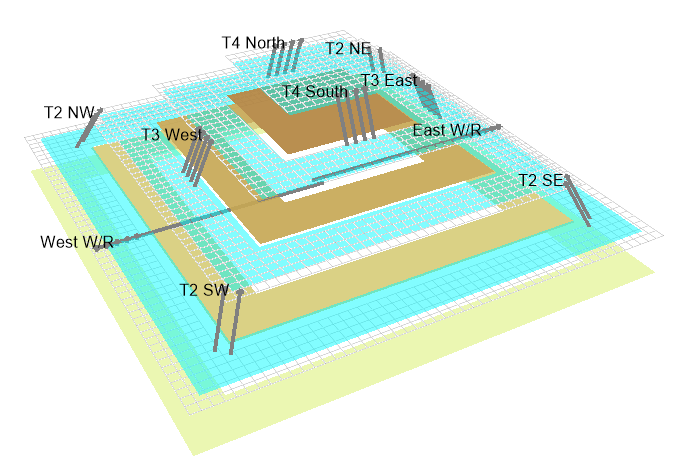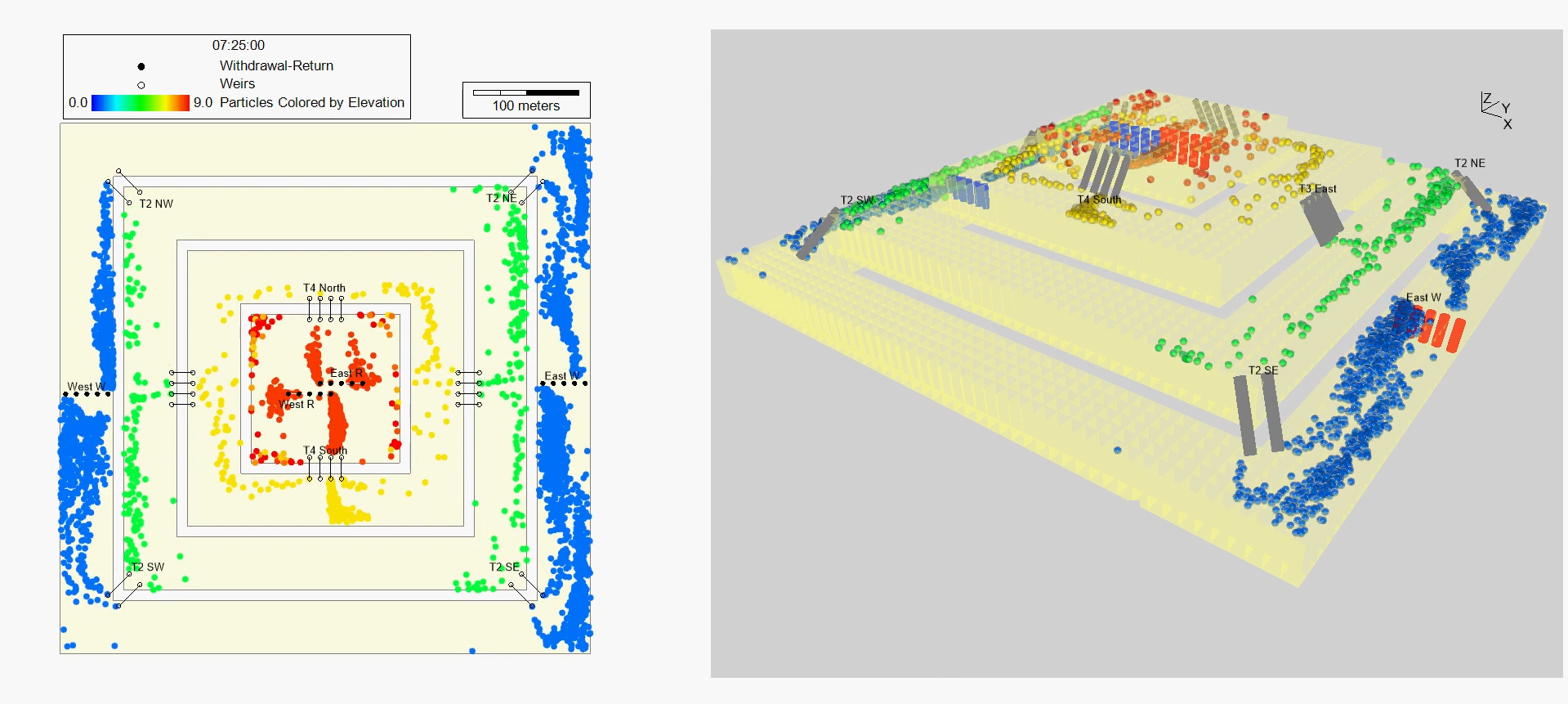Movement of Lagrangian Particles across Hydraulic Structures
Introduction
The Lagrangian Particle Tracking (LPT) module in EFDC+ was developed by DSI in 2009 and has served as an effective tool for solving numerous problems in fluid dynamics related to the simulation and prediction of the trajectory of objects traveling in rivers, lakes, marine systems, and hydraulic structures. The soundness of this module has been demonstrated in various applications and a number of tests with different hydrodynamic regimes and geometries (DSI, 2009). This blog will discuss the EFDC+ simulation of Lagrangian Particles moving in a pyramid-cascading water fountain.
Model Demonstration
The model geometry of the pyramid consists of a square cascade fountain with four steps and a central axis of symmetry. The cascade fountain step widths are 140 m, 260 m, 380 m, and from top to bottom. The height of each step is uniform, with a value of 3 m. Water flows out from the top step of the pyramids and cascades down the steps below. At the bottom, the water collects in a basin, where a pump circulates the water back to the top of the fountain. For the numerical model configuration, a grid of 2,176 uniform cells, and cell size of 10 x 10 m, is used to represent the cascade fountain. Several model hydraulic structures, including pipes connecting the four tiers (T) and withdrawal/return structures (W/R), are set up to simulate the circulation of the flow as shown in Figure 1 and Figure 2.
The EFDC+ LPT module is used to simulate the motion of 4,000 particles in the cascade fountain, seeded at random depths at the center of the top step. The particles are considered neutrally buoyant, so their motion is solely governed by the water’s velocity field. It is noted that the option of “neutrally buoyant particles” is a vital tool in LPT, representing particles that move with the fluid flow without sinking or rising. Random walk is also incorporated into the horizontal movement to represent the diffusion and dispersion of particles due to the turbulent effects.
The model parameters are summarized in Table 1.
Table 1. Parameters for the LPT in a pyramid fountain model.
| Model Parameters | Variable | Value | |
| Grid | Number of Cells | LA | 2176 |
| Cell Dimension | DX, DY | 10x10m | |
| Hydrodynamics | Time Step | ∆t | 0.7s |
| W/R Constant Flow | F | 2 m3/s | |
| LPT | Number of Particles | NPD | 4000 |
| Constant Diffusivity | DIF | 0.01 m2/s | |
| Start (day) | BEGTI | 0.1 | |
| End (day) | ENDTI | 1 |


Visualization of Particle Motion
The simulation results of the particle motion in the pyramid fountain are shown in Figure 3, with both plan and 3D views. Different colors are used to represent particles found at different fountain steps. It can be seen that particles are tracked over time. Starting at the top step, the particles cascade down the first fountain step, following the water flow through the installed pipes, spread out in the horizontal plan before going down to the next step. When the particles reach the bottom, they are pumped back to the top thanks to the withdrawal/return structures on the west side and east side of the basin. As a closed-loop system, the model configuration allows continuous water flow and particle circulation.

Figure 3. Animation of Lagrangian Particle Tracking (LPT) with pyramid fountain
Conclusion
The Lagrangian Particle Tracking (LPT) has been used widely to simulate the movement of pollutants, plastic trash, or biological organisms in the ocean, rivers, and streams. With EEMS, we have demonstrated the capability of the LPT module to simulate the motion of particles in complex geometries, such as a pyramid-cascading water fountain. Additionally, EFDC+ Explorer (EE) can provide a dynamic visualization of particle motion, allowing users to investigate the simulation results efficiently.
Do you want to try these options for yourself? You can start by downloading EEMS, activating the free demo mode, and then running our demonstration models. To see these features in action, head over to our YouTube page.
Please get in touch with us if you have any comments or questions. For more information on EFDC+ capabilities, contact the DSI team today.
Talk to the experts
References
DSI LLC. 2024. EFDC+ Theory, Version 12. Published by DSI LLC, Edmonds, WA. Available at https://eemodelingsystem.com/wpcontent/Download/Documentation/EFDC Theory Document Ver 12.pdf






